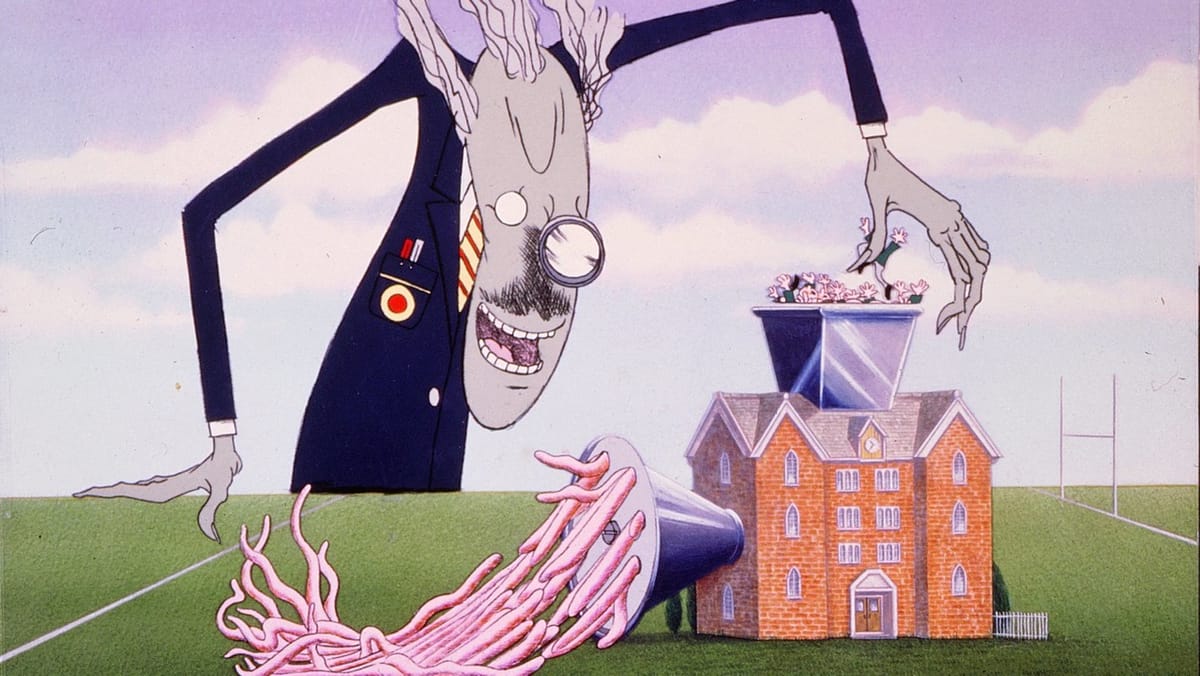The Wall (1979) - Album Review
All in all, you're just another brick in the wall...

-we came in?
The Wall is a 1979 Pink Floyd album, created after their success with The Dark Side of the Moon, Wish You Were Here, and Animals, the first two I've reviewed. It is unique in that it tells a complete story about the life of Pink, a fictional rock star, and his gradual decline into shutting himself away from the world.
Being a double album, the first disc chronicles his life from his rocky childhood, with a father who died in war (the ending of In The Flesh?, The Thin Ice, and Another Brick in the Wall, Part 1), abusive teachers (The Happiest Days of Our Lives, Another Brick in the Wall, Part 2), an overprotective mom (Mother), and living in constant fear of war (Goodbye Blue Sky).
To paraphrase from Dan Olson (Folding Ideas on YouTube), the variety of these childhood events is core to the album's theme: there is no one singular event that causes us to shut ourselves off from the world. They are all just bricks in the wall that keep us from others.
Empty Spaces, Young Lust, and One Of My Turns show that he's resorted to sex and rock and roll (through the style of these tracks) to fill himself: to numb himself from the possible pain the world can bring him. But it becomes unavoidable when his wife finds out he's been cheating on her (Don't Leave Me Now), and combined with his abusive tendencies towards her, she leaves Pink for good.
This causes him to trash his apartment (Another Brick in the Wall, Part 3) and decide, “I don't need anything at all,” finally shutting himself out (Goodbye Cruel World).
The album's first half is very catchy, with the swing of In The Flesh? and the disco beat of Another Brick in the Wall, Part 2 being the best parts for me. The lyrics do a good job of describing his rough childhood and how he's attempted to fill himself with sex, rock and roll, and, as Another Brick in the Wall, Part 3 reveals, drugs.
But this is a double album, and the story isn't over yet.
The second disc takes us straight into the more somber, yet still catchy Hey You, setting the tone for this side onwards. It's more somber, as set with the style of the tracks Is There Anybody Out There? and Nobody Home, which show his new way of living, isolated from everyone else.
But the show must go on, and unfortunately, after some reminiscing of his past in Vera and Bring The Boys Back Home, the ending of that track reveals that he's missing something: that it's “time to go.” This leads us into another hit from this album: Comfortably Numb.
Comfortably Numb takes us into an outside perspective: a doctor trying to get to Pink after a presumed drug overdose, with him and his crew having to shoot up more drugs in him to wake him up, as he has a show to do. The epic guitar makes this very catchy, but you have to go through the album to be able to infer that he's down and out thanks to drugs. This is a weakness of the album that we'll touch on in the end.
But The Show Must Go On, and Pink goes out to perform In The Flesh: the same song we heard at the beginning. Only this time, something's different about him. He starts acting like a Neo-Nazi, calling out minorities and queers in his concert, telling his audience to “lay them up against the wall”, that “if I had my way, I'd have all of you shot”. He's now mad at everyone and wants to take out that anger using his devoted fans.
Thus, the frenetic Run Like Hell takes us into his gradual desire to destroy everything, and Waiting For The Worms solidifies it, with loudspeakers of Pink shouting instructions to his new army throughout the track. Yet, it's also littered with the main melody from the three parts of Another Brick In The Wall, which subtly indicates that this is all based on all the bad things that have happened to him. Now it's his time to take revenge on all the people who hurt him: his teachers, his mother, and his lover.
Until it gets too far.
Stop acts as an interlude, where Pink realizes that maybe this is all wrong. Thus, he, and likewise we, take a trip into his mind through The Trial, where he judges himself based on the people who had hurt him in a caricature manner. Interestingly, his lover, his ex-wife, has the best point out of the three people he meets: that he was neglectful and ended up cheating on her with other women.
Regardless, the conclusion is clear: he's still hurting people, and the imaginary judge orders him to “tear down the wall,” finally reopening himself to society. This leads us into the final track: Outside The Wall, which oddly has the same melody as the very beginning of the album In The Flesh?. And the very end has a speaker saying, “isn't this where-” before getting cut out and ending the album.
Except, it's not over. The very beginning of In The Flesh?, the opener to the album, has that same man saying “-we came in?”.
“Isn't this where we came in?”
Pink may have torn down his wall and become a new person, but if he's not careful, he may fall back into that destructive cycle, making the same old mistakes. The ambiguity of this ending leaves his ultimate fate for us to decide. Has he changed or not? Will he improve even knowing if it’s wrong to shut yourself off from society?
This is a very complete story, and it's all told through song. Combined with a still topical theme about isolation from others in fear that they will hurt us, it's easily become one of my favorite albums I've ever listened to.
However, as seen in Comfortably Numb and the second half of the first album, the fact that the story is told only through song is the biggest weakness for me: you still get the general story that's happening, but the details are left to be desired. A visual aspect is very much welcome to tell this story, which is why a 1982 film adaptation of this album, written by Roger Waters, frontman of Pink Floyd, was made. There is only so much you can tell through catchy songs.
Another weakness is that the second half is overall less catchy than the first half. This may be by design, as the second half takes us into Pink’s complete isolation from society, whereas the first half essentially montages us through his past to see what brought him to build that wall. It does explain why the second half is more melancholic, with way less drumming and epic guitars, the only exceptions being Hey You, Comfortably Numb, and In The Flesh. Serves the narrative well, yes, but still less catchy than the first, especially with The Happiest Days of Our Lives leading into the protest song Another Brick in the Wall, Part 2.
There is one more thing I would like to touch on, which can either be a positive or negative: nearly every track blends into the other, just like The Dark Side Of The Moon and Wish You Were Here, which I also reviewed. Comfortably Numb manages to stand on its own, as the track before that, Bring The Boys Back Home, ends in complete silence, and the track itself fades out into emptiness before kicking back into high gear with The Show Must Go On.
It means the best way to listen to the album is in one go, no shuffle. It gives you the story being told in a very fluid way, but it does suck when you want to add it into playlists. There will usually be a weird part in the very start or very end that can make it feel like it just got suddenly cut off, whereas if you listen to the album in one go, those jarring endpoints blend into each other very well. This is something consistent with the Pink Floyd I’ve listened to, and whether you view it as a positive or negative (I view it as a positive) is really up to you.
Overall, despite the difference between the two albums of this massive double album, the lack of details due to the limitations of the song, and the fact that the album is not exactly shuffle-friendly thanks to its endpoints, this is probably still my favorite album I’ve ever listened to. The complete story it tells, with the themes of isolation and inability to connect with others, thanks to our histories, still rings true today. And it’s accompanied by some amazing tracks, with Another Brick in the Wall, Part 2 just reaching 1.02 billion streams on Spotify. The guitar solo in Comfortably Numb is still amazing, as is the in my opinion underrated One Of My Turns, whose second half is so incredibly catchy to me. And despite the limitations of songs, the recurring leitmotifs in the second album are an amazing touch that connects the first album to the second, creating a whole, coherent, double album.
I rate this album a 9/10, and my favorite track is Comfortably Numb.
Isn't this where-





